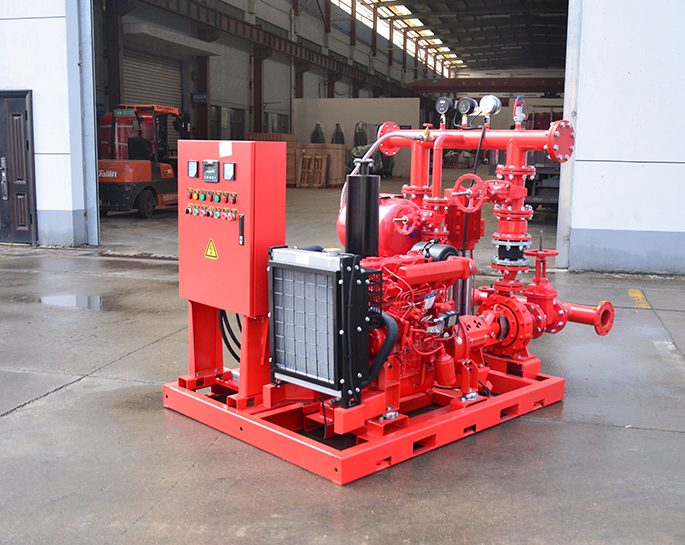How is the performance of fire pumps affected by changes in water temperature?
Jan 31, 2024
Share:
The performance of fire pumps can be influenced by changes in water temperature. Here are some ways in which water temperature can affect the performance of fire pumps:
1. **Viscosity Changes:**
- Water viscosity is affected by temperature changes. As water temperature decreases, its viscosity increases, making it more resistant to flow. This can result in higher friction losses within the pump and piping system, reducing overall efficiency.
2. **Pump Efficiency:**
- The efficiency of pumps is typically affected by the viscosity of the fluid being pumped. Lower temperatures can increase the viscosity of water, which may lead to decreased pump efficiency. This can result in higher energy consumption and reduced flow rates.
3. **Cavitation Risk:**
- Cold water temperatures increase the risk of cavitation. Cavitation occurs when the pressure in the pump drops below the vapor pressure of the water, leading to the formation of vapor bubbles. When these bubbles collapse, they can cause damage to pump components. Proper pump design and operation considerations are necessary to mitigate the risk of cavitation.
4. **Material Properties:**
- The temperature of the water can affect the material properties of pump components. Extreme temperatures, whether hot or cold, may impact the integrity and lifespan of seals, gaskets, and other materials used in the pump construction. It's essential to choose materials that can withstand the expected temperature variations.
5. **Pump Speed and Power:**
- Water temperature can influence the pump's speed and power requirements. Changes in temperature can affect the density and, consequently, the mass flow rate of water. Pump performance curves may need to be adjusted to account for temperature variations.
6. **Pump Suction Conditions:**
- Low temperatures can lead to freezing or ice formation, especially in outdoor installations. This can affect the suction conditions of the pump, potentially causing blockages or damage. Proper insulation and heating systems may be required to prevent freezing.
7. **System Design Considerations:**
- The overall system design, including pipe sizing and layout, may need to account for changes in water temperature to maintain optimal performance. Cold temperatures, for example, can increase the likelihood of pipe freezing and may necessitate additional insulation measures.
8. **NFPA Standards:**
- The National Fire Protection Association (NFPA) provides guidelines for fire pump installations, and these guidelines may include considerations for water temperature variations. Compliance with NFPA standards is essential to ensure the reliability and effectiveness of fire pump systems.
In summary, water temperature can have several effects on the performance of fire pumps, including changes in viscosity, increased risk of cavitation, and potential impacts on pump materials. System designers and operators should carefully consider these factors and take appropriate measures to ensure that fire pump systems are designed and operated to perform effectively under various temperature conditions.

1. **Viscosity Changes:**
- Water viscosity is affected by temperature changes. As water temperature decreases, its viscosity increases, making it more resistant to flow. This can result in higher friction losses within the pump and piping system, reducing overall efficiency.
2. **Pump Efficiency:**
- The efficiency of pumps is typically affected by the viscosity of the fluid being pumped. Lower temperatures can increase the viscosity of water, which may lead to decreased pump efficiency. This can result in higher energy consumption and reduced flow rates.
3. **Cavitation Risk:**
- Cold water temperatures increase the risk of cavitation. Cavitation occurs when the pressure in the pump drops below the vapor pressure of the water, leading to the formation of vapor bubbles. When these bubbles collapse, they can cause damage to pump components. Proper pump design and operation considerations are necessary to mitigate the risk of cavitation.
4. **Material Properties:**
- The temperature of the water can affect the material properties of pump components. Extreme temperatures, whether hot or cold, may impact the integrity and lifespan of seals, gaskets, and other materials used in the pump construction. It's essential to choose materials that can withstand the expected temperature variations.
5. **Pump Speed and Power:**
- Water temperature can influence the pump's speed and power requirements. Changes in temperature can affect the density and, consequently, the mass flow rate of water. Pump performance curves may need to be adjusted to account for temperature variations.
6. **Pump Suction Conditions:**
- Low temperatures can lead to freezing or ice formation, especially in outdoor installations. This can affect the suction conditions of the pump, potentially causing blockages or damage. Proper insulation and heating systems may be required to prevent freezing.
7. **System Design Considerations:**
- The overall system design, including pipe sizing and layout, may need to account for changes in water temperature to maintain optimal performance. Cold temperatures, for example, can increase the likelihood of pipe freezing and may necessitate additional insulation measures.
8. **NFPA Standards:**
- The National Fire Protection Association (NFPA) provides guidelines for fire pump installations, and these guidelines may include considerations for water temperature variations. Compliance with NFPA standards is essential to ensure the reliability and effectiveness of fire pump systems.
In summary, water temperature can have several effects on the performance of fire pumps, including changes in viscosity, increased risk of cavitation, and potential impacts on pump materials. System designers and operators should carefully consider these factors and take appropriate measures to ensure that fire pump systems are designed and operated to perform effectively under various temperature conditions.


.png)
.png)

.png)


